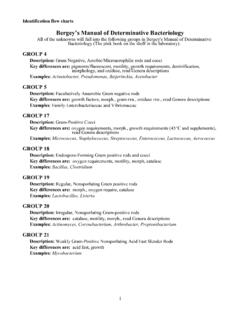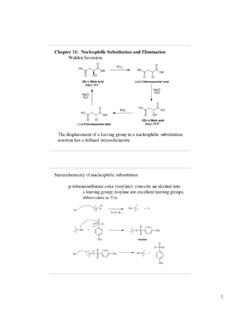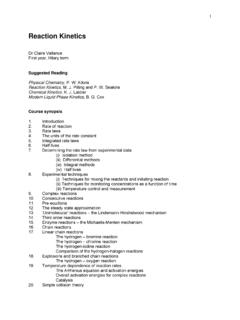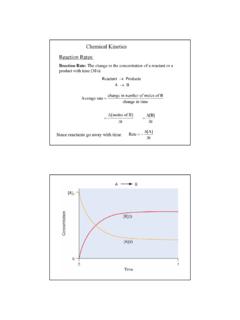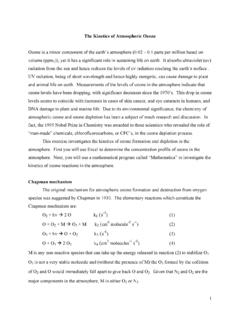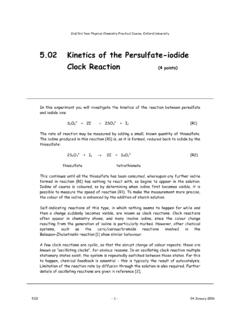Transcription of Chapter 13 Kinetics: Rates and Mechanisms of Chemical ...
1 14-1 kinetics : Rates and Mechanisms of Chemical reactions Focusing on Reaction Rate Expressing the Reaction Rate The Rate Law and Its Components Integrated Rate Laws: Concentration Changes over Time Catalysis: Speeding Up a Reaction Theories of Chemical kinetics Reaction Mechanisms : The Steps from Reactant to Product Chapter 13 2013 McGraw-Hill Ryerson Limited14-2 Factors That Influence Reaction Rate Particles must collide in order to react. The higher the concentration of reactants, the greater the reaction rate. A higher concentration of reactant particles allows a greater number of collisions.
2 The physical state of the reactants influences reaction rate. Substances must mix in order for particles to collide. The higher the temperature, the greater the reaction rate. At higher temperatures particles have more energy and therefore collide more often and more effectively. 2013 McGraw-Hill Ryerson Limited14-3 Figure The effect of surface area on reaction rate. A hot steel nail glows feebly when placed in O2. The same mass of steel wool bursts into flame. 2013 McGraw-Hill Ryerson Limited14-4 Figure Sufficient collision energy is required for a reaction to occur.
3 2013 McGraw-Hill Ryerson Limited14-5 Expressing the Reaction Rate Reaction rate is measured in terms of the changes in concentrations of reactants or products per unit time. For the general reaction A B, we measure the concentration of A at t1 and at t2: The negative sign is used because the concentration of A is decreasing. This gives the rate a positive value. (conc ) t Rate = change in concentration of A change in time conc A2 - conc A1 t2 - t1 = - = - Square brackets indicate a concentration in moles per liter. 2013 McGraw-Hill Ryerson Limited14-6 Table Concentration of O3 at Various Times in its Reaction with C2H4 at 303 K Time (s) Concentration of O3 (mol/L) [C2H4] t rate = - [O3] t = - 2013 McGraw-Hill Ryerson Limited14-7 Figure Three types of reaction Rates for the reaction of O3 and C2H4.
4 2013 McGraw-Hill Ryerson Limited14-8 Figure Plots of [reactant] and [product] vs. time. C2H4 + O3 C2H4O + O2 [O2] increases just as fast as [C2H4] decreases. Rate = - [C2H4] t = - [O3] t [C2H4O] t [O2] t = = 2013 McGraw-Hill Ryerson Limited14-9 Figure Plots of [reactant] and [product] vs. time. H2 + I2 2HI [HI] increases twice as fast as [H2] decreases. Rate = - [H2] t = - [I2] t = [HI] t 1 2 [I2] t Rate = [H2] t [IH] t = -2 = -2 The expression for the rate of a reaction and its numerical value depend on which substance serves as the reference.
5 2013 McGraw-Hill Ryerson Limited14-10 In general, for the reaction aA + bB cC + dD 1 a [A] t 1 b [B] t rate = - = - 1 c [C] t = 1 d [D] t = where a, b, c, and d are the coefficients for the balanced equation, the rate is expressed as: 2013 McGraw-Hill Ryerson Limited14-11 Sample Problem Expressing Rate in Terms of Changes in Concentration with Time PROBLEM: Hydrogen gas has a nonpolluting combustion product (water vapor). H2 is used as a fuel abord the space shuttle and in earthbound cars with prototype engines: 2H2(g) + O2(g) 2H2O(g) (a) Express the rate in terms of changes in [H2], [O2], and [H2O] with time.
6 (b) When [O2] is decreasing at mol/L s, at what rate is [H2O] increasing? PLAN: We choose O2 as the reference because its coefficient is 1. For every molecule of O2 that disappears, two molecules of H2 disappear, so the rate of [O2] decrease is the rate of [H2] decrease. Similarly, the rate at which [O2] decreases is the rate at which [H2O] increases. 2013 McGraw-Hill Ryerson Limited14-12 Sample Problem SOLUTION: (a) = [H2O] t 1 2 Rate = - [O2] t = - [H2] t 1 2 (b) Calculating the rate of change of [H2O]: = - [H2O] t 1 2 [O2] t = -( mol/L s) = 2( mol/L s) [H2O] t = mol/L s 2013 McGraw-Hill Ryerson Limited14-13 The Rate Law For any general reaction occurring at a fixed temperature aA + bB +.
7 CC + dD +.. Rate = k[A]m[B]n .. The term k is the rate constant, which is specific for a given reaction at a given temperature. The exponents m and n are reaction orders and are determined by experiment. The values of m and n are not necessarily related in any way to the coefficients a and b. 2013 McGraw-Hill Ryerson Limited14-14 Reaction Orders A reaction has an individual order with respect to or in each reactant. For the simple reaction A products: If the rate doubles when [A] doubles, the rate depends on [A]1 and the reaction is first order with respect to A.
8 If the rate quadruples when [A] doubles, the rate depends on [A]2 and the reaction is second order with respect to [A]. If the rate does not change when [A] doubles, the rate does not depend on [A], and the reaction is zero order with respect to A. 2013 McGraw-Hill Ryerson Limited14-15 Figure Plots of reactant concentration, [A], vs. time for first-, second-, and zero-order reactions . 2013 McGraw-Hill Ryerson Limited14-16 Figure Plots of rate vs. reactant concentration, [A], for first-, second-, and zero-order reactions . 2013 McGraw-Hill Ryerson Limited14-17 Individual and Overall Reaction Orders For the reaction 2NO(g) + 2H2(g) N2(g) + 2H2O(g): The rate law is rate = k[NO]2[H2] The reaction is second order with respect to NO, first order with respect to H2 and third order overall.
9 Note that the reaction is first order with respect to H2 even though the coefficient for H2 in the balanced equation is 2. Reaction orders must be determined from experimental data and cannot be deduced from the balanced equation. 2013 McGraw-Hill Ryerson Limited14-18 Sample Problem SOLUTION: Determining Reaction Orders from Rate Laws PLAN: We inspect the exponents in the rate law, not the coefficients of the balanced equation, to find the individual orders. We add the individual orders to get the overall reaction order. (a) The exponent of [NO] is 2 and the exponent of [O2] is 1, so the reaction is second order with respect to NO, first order with respect to O2 and third order overall.
10 PROBLEM: For each of the following reactions , use the give rate law to determine the reaction order with respect to each reactant and the overall order. (a) 2NO(g) + O2(g) 2NO2(g); rate = k[NO]2[O2] (b) CH3 CHO(g) CH4(g) + CO(g); rate = k[CH3 CHO]3/2 (c) H2O2(aq) + 3I-(aq) + 2H+(aq) I3-(aq) + 2H2O(l); rate = k[H2O2][I-] 2013 McGraw-Hill Ryerson Limited14-19 Sample Problem (b) The reaction is order in CH3 CHO and order overall. 3 2 3 2 (c) The reaction is first order in H2O2, first order in I-, and second order overall. The reactant H+ does not appear in the rate law, so the reaction is zero order with respect to H+.
